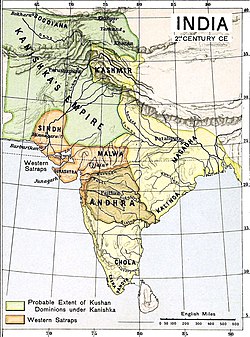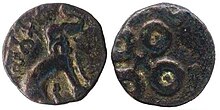Satavahana dynasty
Satavahana Empire (Andhras) | |||||||||||||||||||||
|---|---|---|---|---|---|---|---|---|---|---|---|---|---|---|---|---|---|---|---|---|---|
| Late 2nd century BCE–Early 3rd century CE | |||||||||||||||||||||
 Approximate extent of the Satavahana Empire, here "Andhra" in ocher.[1] | |||||||||||||||||||||
| Capital | Pratishthana, Amaravati | ||||||||||||||||||||
| Common languages | Prakrit, Sanskrit, Dravidian[2][3] | ||||||||||||||||||||
| Religion | Hinduism, Buddhism | ||||||||||||||||||||
| Government | Monarchy | ||||||||||||||||||||
| King | |||||||||||||||||||||
| Historical era | Classical India | ||||||||||||||||||||
• Established | Late 2nd century BCE | ||||||||||||||||||||
• Disestablished | Early 3rd century CE | ||||||||||||||||||||
| |||||||||||||||||||||
| Today part of | India[4] | ||||||||||||||||||||
| Satavahana Empire 100 BCE–2nd c. CE | ||||||||||||||||||||||
|---|---|---|---|---|---|---|---|---|---|---|---|---|---|---|---|---|---|---|---|---|---|---|
|
||||||||||||||||||||||
The Satavahanas (Sādavāhana or Sātavāhana,[5] IAST: Sātavāhana), also referred to as the Andhras in the Puranas, were an ancient Indian dynasty based in the Deccan region. Most modern scholars believe that the Satavahana rule began in the late second century BCE and lasted until the early third century CE, although some assign the beginning of their rule to as early as the 3rd century BCE based on the Puranas, but uncorroborated by archaeological evidence.[6] The Satavahana kingdom mainly comprised the present-day Andhra Pradesh, Telangana, and Maharashtra. At different times, their rule extended to parts of modern Gujarat, Madhya Pradesh, and Karnataka. The dynasty had different capital cities at different times, including Pratishthana (Paithan) and Amaravati (Dharanikota).
The origin of the dynasty is uncertain, but according to the Puranas, their first king overthrew the Kanva dynasty. In the post-Maurya era, the Satavahanas established peace in the Deccan region and resisted the onslaught of foreign invaders. In particular their struggles with the Saka Western Satraps went on for a long time. The dynasty reached its zenith under the rule of Gautamiputra Satakarni and his successor Vasisthiputra Pulamavi. The kingdom fragmented into smaller states by the early 3rd century CE.
The Satavahanas were early issuers of Indian state coinage struck with images of their rulers. They formed a cultural bridge and played a vital role in trade and the transfer of ideas and culture to and from the Indo-Gangetic Plain to the southern tip of India. They supported Hinduism as well as Buddhism and patronised Prakrit literature.
Origins
The date and place of origin of the Satavahanas, as well as the meaning of the dynasty's name, are a matter of debate among historians. Some of these debates have happened in the context of regionalism, with the present-day Andhra Pradesh, Maharashtra, Karnataka and Telangana being variously claimed as the original homeland of the Satavahanas.[7]
Etymology

(

